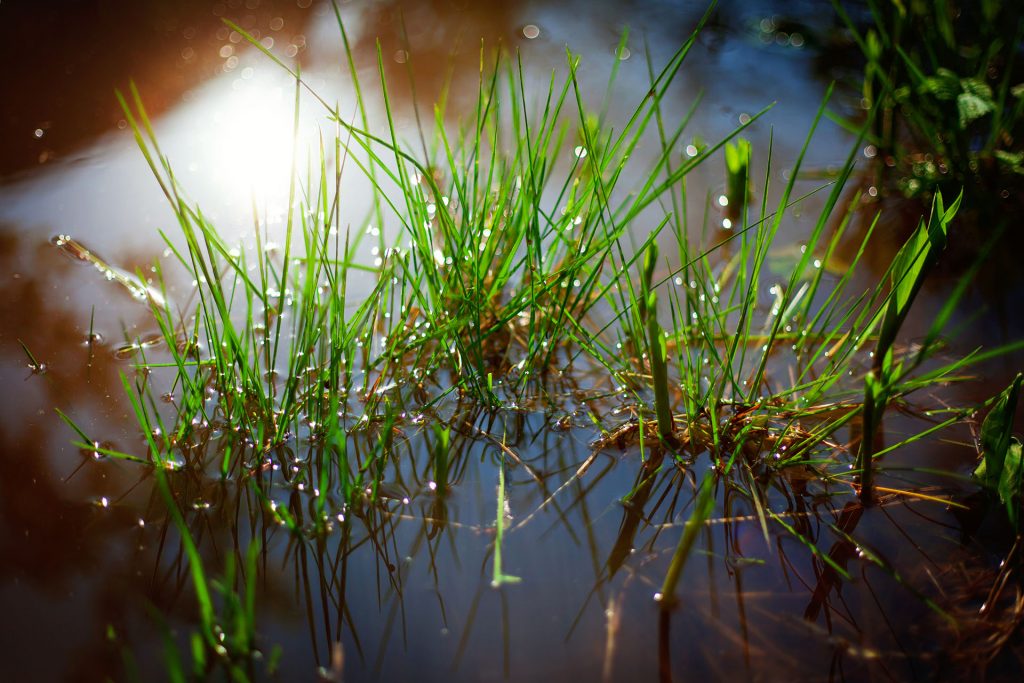
Spring so far has been unusually wet. All that rain may be a boon to our reservoirs and water sports enthusiasts. But it’s a bit too much of a good thing for our lawns. The right rain at the right time helps your lawn green up in the spring without extra irrigation. But too much rain and even flooding can wreak havoc on your turf. Luckily, if your lawn has been the victim of rain damage, all hope is not lost. Depending on the amount of water, the temperature, and how long the water persists, you may have some options. It is possible to save a lawn even after flooding. Here are the steps to take to keep your turf safe and revive it after flood and rain damage.
![Treating Your Lawn After Rain Damage [infographic]](https://theturfgrassgroup.com//wp-content/uploads/2020/04/Treating-Your-Lawn-After-Rain-Damage-infographic.jpg)
1. Prepare Your Lawn
When heavy rains are pouring down, and rivers and waterways are threatening to flood, you have a lot on your mind. Your lawn may not be at the top of the list. However, a little pre-planning can go a long way.
First, before the rainwater overtakes your lawn, turn off the sprinkler system. This may seem like common sense, but in an intense situation, it is easy to forget. To help you remember, make it a habit to turn off the sprinkler system any time heavy rain is forecast. A more foolproof alternative is to install a smart irrigation system. A smart system uses data from the internet to predict weather and adjust watering schedules. So when the heavy rains start to fall, your sprinkler system will go into hibernation.
The next thing to do is to snap a few pictures as the rain starts to collect. In almost every lawn, some areas will begin to collect water before others. Taking photos will allow you to come back to your lawn after the flooding with some new knowledge. Your pictures can show where the drainage hotspots are. Once your yard is back to normal, you will need to target areas that saw early puddling and flooding. While the weather is pleasant, repair those areas by leveling the ground and installing adequate drainage.
2. Rain Damage During a Flood
There isn’t much to do about your lawn while it is covered with water. If the water is deep enough to flood your home, your priority should be your safety and the safety of your family. Your turf can wait.
During a flood, the greatest danger to your grass is suffocation. Grass needs sunlight, water, air—CO2, to be precise—and nutrients to grow. When your turf is submerged, the grass cannot get the CO2 it needs. It can survive this way for a day or two, but after four of five days, the chances of survival drop significantly. Generally, cool water and cool temperatures are the least destructive. If the air temperature is above 80 degrees and the water is shallow enough to be warmed, even a day or two could kill the grass. The best situation is if at least the leaves of your grass are not entirely submerged. However, if water is covering the entire plant, your best hope is for the water to drain quickly.
Another danger from flooding is silt. Floodwaters, or even heavy rain, can carry silt that deposits on your lawn and stays there. Silt can also choke off vital air, light, and nutrients your grass needs. A similar danger to silt is runoff. Heavy rains can send runoff flowing down into your lawn. If that runoff carries pollution or chemicals that are harmful to your grass, expect your grass to be affected.
3. Immediately After the Flood
As tempting as it may be to get out onto your lawn and start clearing debris and silt, now is the time to wait. Walking on a saturated lawn can cause deep ruts that destroy turf. Often, the worst rain damage is not from the rain itself. It is the result of walking on wet turf and creating a muddy mess. As much as you want to get out there, let the ground dry first.
When the soil is dry enough that walking on it doesn’t leave a footprint or a rut, it’s time to start cleaning up. First, get the big stuff. Storm waters or floodwaters can carry debris that, if left on your lawn, well prevent the grass from growing back. Get a trash bin and clear your lawn of debris. Next, go after smaller items and silt with a good rake. It can be hard to remove everything that isn’t supposed to be there. But the more you can clear your lawn, the better it will spring back from a stressful event.
4. As the Ground Dries More
As the ground dries, you can start to perform reparative therapy. Your lawn has suffered serious trauma, and it will take some TLC to get it back into shape.
One issue with heavy rains or floodwaters is that the water can wash away nutrients in the soil. If your grass is looking yellow or faded, you may need to add some fertilizer beyond what you normally use. But be careful. Rainwaters can also carry weed seeds. When the grass is damaged, it is less able to crowd out weeds. And when you lay down fertilizer, you are also fertilizing the weeds. It may be a good idea to use both fertilizer and a pre-emergent herbicide as you would in early spring.
Rain damage extends beyond the damage to the grass plants themselves. Heavy rains or floodwaters can also affect the soil. Flowing water can strip away the top layer of fertile soil, and compact the soil below. Once the ground is dry, it is time to aerate. Check the soil when it is completely dry and use your best judgment. If the soil is still light and airy, you may not need to aerate. But if it is compacted, rent a good plug aerator and aerate your lawn.
Now is also the time to look out for fungus growth. A few mushrooms can be cleared by regular mowing. But saturated earth can also make room for fungi that damage the grass. You may need to spot-treat fungal growth on your turf. Also, if you notice a ring of mushrooms—often fancifully called a fairy ring—try to pull out the mushrooms from the root. A fairy ring can compete for water with the grass inside, so it’s best to remove the mushrooms altogether.
5. Mowing After Rain Damage
When the water has subsided, and the lawn is dry, it’s time to mow. Resist the urge to mow too soon. Mowing wet grass can be more harmful than helpful. Usually, we recommend keeping the grass on a residential lawn as long as possible. Longer grass can shade the soil and help maintain moisture, and it crowds out weeds. But after heavy rain, cut the grass a little shorter. Closely-cropped turf will allow the soil to dry more quickly. Bermudagrass, Zoysiagrass, and other warm-weather varietals don’t like saturated soil. So even if the top layer feels dry, you want to make it as easy as possible for the soil to dry out completely.
6. Preparing for Future Rain Damage
Once your lawn is mostly back to normal, it’s time to think about the next heavy rain. Remember those pictures you took? Now is the time to look back at them and figure out where water gathers when it rains. A well-maintained lawn should drain water evenly across the entire lawn. However, most lawns have some areas that drain better than others. Look for the areas where water was pooling. Check if the ground is even or if a slight dip might account for the collecting water. If your lawn isn’t level, now is the time to add dirt and level it.
Another feature of your lawn that could account for pooling water is the soil makeup and density. Soil with a high clay content absorbs water less efficiently than other types of soil. Compacted soil also drains poorly. If your soil is clay-rich or just compacted, give those areas a once-over with the aerator to loosen things up.
You may also consider adding drainage to your lawn. A french drain is a discrete way to add drainage where water tends to collect. Another popular drainage method is to add a dry creek bed. A dry creek bed becomes another feature of your landscaping, and during heavy rains, it can effectively divert a large amount of water. If you go this route, make sure that the rest of your lawn is slightly graded to send water to the creek bed. Otherwise, it won’t be much help.
Heavy rains and flooding can seem catastrophic. And the worst flooding can kill off your entire lawn. But in many cases, the damage is temporary and reversible. Starting with strong, healthy turf provides the best chance for survival. Try TifTuf Bermudagrass for your lawn and see the difference a sod can make. You can find a grower here.
